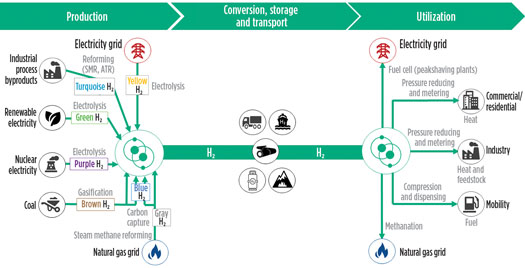Measurement and Instrumentation
How H2 production technology will enable the transition to a green economy
The promise of safe and reliable hydrogen generation and distribution can be both exciting and daunting. On one hand, H2 is a sustainable answer to growing energy demands across the globe. On the other hand, clean H2 production is still limited, mainly due to high costs and the need for more advanced technologies in the production chain. Looking to the future where H2 is a stable and renewable fuel source, the first step will be developing and improving existing processes, tools and infrastructure to handle this challenging application. Only then will it be possible to embrace an H2-fueled world.
H2 is dispensed at extremely high pressures compared to other fuels. The main design criteria when creating instruments and equipment for H2 fuel is to be able to withstand these incredibly high-pressure ratings. If existing infrastructure can be updated to accommodate these challenges, then the industry will be better equipped to safely produce, store, move and use H2 in a cost-effective way. Investments in these technologies made today will be critical in shaping opportunities for a smooth transition to alternative fuels in the future.
H2 fuel is comparable to fossil fuels but three times as powerful and useful as gasoline. Internal combustion engines that use H2 operate at higher efficiency levels, too—80% compared to 25% of most other combustion engines. Energy-efficient hybrid vehicles today could travel twice the distance on a full tank of fuel vs. a regular passenger vehicle. This begs the question: Why is H2 not already being used as a primary fuel source?
H2 must be kept compressed under high pressures to be useable as an efficient energy source. This makes transportation, storage and distribution especially difficult. Not only will the existing infrastructure need to be overhauled to accommodate it, but also dispensing compressed H2 at the fuel pump can be a safety hazard if special equipment to withstand the high pressure is not used.
Refineries already use large amounts of H2 as part of their hydrocarbon processing. For example, H2 is necessary for the process of removing sulfur from crude oil. Refineries, therefore, have much experience producing H2 from natural gas. From this experience, we know much about manufacturing what is known as blue H2. These experiences have aided the development of sophisticated tools and technologies that can withstand these higher levels of pressure, like high-pressure Coriolis flowmeters and non-invasive, wireless monitoring solutions that will aid the journey to fully embracing H2 fuel.
The path to zero emissions is paved with various colors in H2 value chains (Fig. 1). Green H2 is ideal, as it is created using renewable energy instead of fossil fuels. It will take some time to get to the point where green H2 is the norm. In the meantime, adaptions to existing infrastructures with the technologies developed for the production of blue H2, ready and available today, will bring that reality closer to being realized.

Fig. 1. A graphic overview of the H2 value chain.
Sustainable H2 production begins with electrolysis, a zero-emissions process using an electric current to split water into H2 and oxygen. Electrolyzers are the systems that producers use to perform electrolysis to create H2 on a large scale. Proton exchange membrane (PEM) electrolyzers are the frontrunner for industrialized electrolysis because implementation is simple, there is no corrosion factor and maintenance is more straightforward.
However, to be considered fully “green,” the energy used to drive the electrolysis process must come from renewable sources. This requirement drives up the cost of PEM electrolysis and the costs of logistics when that energy source is not co-located with the H2 generation itself.
Although these systems are in their early design stages, progress is being made to discover operational efficiencies and in scaling up for production-chain manufacturing. Further process improvements like increasing current density, improving water purification and enhancing safety and reliability are still necessary to drive down the expense of these operations and to maximize returns in these large-scale H2 plants.
Digital twin technology has been instrumental in facilitating the advancement of this process in a safe and controlled environment. By creating a virtual replica of the production process, including all equipment, instrumentation and controls, this software enables operators to simulate the process in real time for training and optimization purposes. These software-based, risk-free environments are already helping manufacturers design and test improvements to H2 electrolysis projects.
Blended streams: Natural gas and H2. Another step forward lies in blending H2 into natural gas streams. By injecting H2 into natural gas networks, the amount of natural gas being used can be offset without losing any of its energy output. Early studies show that up to 30% of a natural gas stream can be blended with H2 without significant modifications to downstream equipment at the point of combustion. It is one of the most promising opportunities for decarbonization for the natural gas industry. Still, it comes with a few key obstacles: corrosion from H2 embrittlement, H2 leaks through rubber parts due to the small dimensions of the molecule, and lower energy per volume delivered.
Cutting-edge, noninvasive corrosion monitoring systems can be deployed along pipelines to detect issues and alert operators before corrosion becomes a more significant problem. The latest corrosion detection tools help ensure pipeline integrity with sensing technologies designed with the specific needs of H2 blended pipelines in mind. Wireless monitoring and autonomous capabilities will assist in identifying leaks remotely, enhancing safety and environmental protection.
Transmitter-style gas chromatographs will be valuable in these applications, as well. Utilizing advanced gas composition analysis, these field-mountable devices will continuously analyze the components of the blend to ensure that the correct ratio of H2 to natural gas is being delivered.
Proper flow measurement solutions will make a significant difference in H2 fuel dispensing stations. As mentioned earlier, the high pressure of H2 applications can create safety issues. When these dispensing applications are in the public domain, safety regulations are incredibly stringent—for good reason. Pumping H2 fuel into a personal vehicle should not be a risky maneuver.
Forward-thinking flowmetering technology designed specifically for the 350-bar and 700-bar, high-pressure H2 dispensing applications is the answer. High-pressure Coriolis flowmeters have already been tested in the most demanding oil and gas applications in the world, and are some of the safest and most accurate devices for high-pressure environments on the market. This technology has been used in the design of fit-for-purpose technology to tackle high-pressure H2 fuel dispensing at the pump.
By 2040, the U.S. alone is expected to have around 10,000 H2 fuel dispensing stations. The industry requires leading-edge measurement solutions that can handle changing pressures at high levels without compromising safety or accuracy. Fortunately, these instruments are available today. These compact Coriolis flowmeters provide a direct inline measurement of mass flow and temperature from a single device. Innovative additions to the design, such as rupture disks, keep operations and customers safe. Digital enhancements, like onboard diagnostics and continuous monitoring software, will help prevent unplanned shutdowns and under- or over-dispensing, saving producers money.
Data analytics and software technologies will be crucial to making H2 fuel more affordable and accessible. Producers benefit from computational power that helps them accurately predict dispensing levels to mitigate maintenance costs and better manage operational efficiencies.
Connected devices in a full-scale digital ecosystem are becoming the standard across the energy industry. Operators with integrated systems and state-of-the-art analytics, modeling and simulation tools have crucial insight into their processes, which drives better decision-making and leads to operational improvements. The new H2-fueled industry will significantly benefit from digital transformation, especially as IIoT-powered devices and practical, scalable digital solutions are on the market and ready to be deployed.
H2 is poised to transform the energy infrastructure. Although the transition will not happen all at once, the tools and technologies are available today to take a scalable approach to embracing H2 that will reduce risk during the transition to a more sustainable future. The challenge will be selecting the right tools and processes to generate early successes while remaining flexible enough to adapt as technology advances over time.

Brandon Bromberek is Vice President of oil and gas for the measurement solutions group at Emerson’s Automation Solutions business. His focus is on applying Emerson’s technology portfolio to help customers enhance production, reduce costs and decrease environmental impact. His present interests lie in supporting the industry as it transitions to a more sustainable future through programs focused on areas such hydrogen, carbon capture and emissions management. Mr. Bromberek holds a BS degree in mechanical engineering from Purdue University in Indiana, U.S. and an MS degree in management for the oil and gas industry from Heriot-Watt University in Scotland.